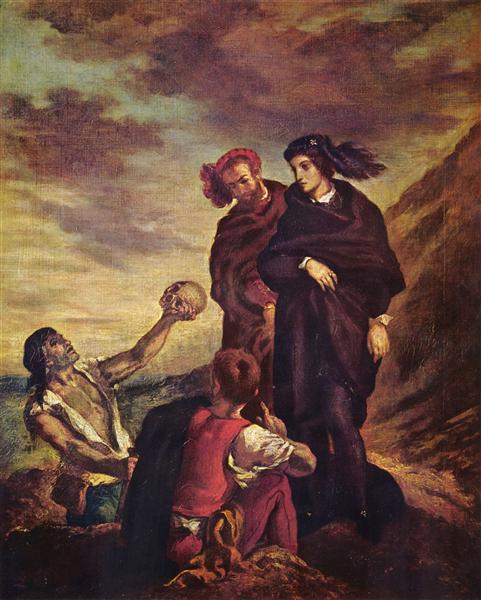Description
Eugène Delacroix's Hamlet and Horatio in the Churchyard, painted in 1839, is a fascinating example of Romanticism, characterized by its emotional heightening and dramatic depiction of reality. This painting captures a moment of contemplation and reflection, where the iconic characters of Shakespeare's tragedy are faced with mortality, symbolized by the looming and ominous surroundings of the cemetery. Known for his passion and mastery in the use of color, Delacroix offers a visual representation that not only evokes the literary characters, but also establishes a profound dialogue with the viewer about life and death.
In the composition, Hamlet and Horatio are presented in front of a gloomy landscape, where the dim light seems to filter through a leaden sky. The figure of Hamlet, standing in the foreground, is central to the work, his fixed posture denoting a sense of anguish and loss. The expression on his face, subtle but clearly marked by concern, invites identification with his internal suffering. At his side, Horatio, lower in the hierarchy of the composition, represents support and friendship, adding a sense of camaraderie amidst the unrest.
Delacroix uses a palette of dark, muted tones, with greys and browns predominating, interspersed with the more vivid flesh of the main characters. This colour choice not only reinforces the sense of hopelessness, but also allows the viewer to focus on the human figures, highlighting the fragility of existence against the backdrop of the vast, imposing silence of the cemetery. The loose brushstroke technique, so typical of Delacroix, adds dynamism to the scene, as the background is constructed with a use of layers that suggests movement and depth, contrasting with the stillness of the characters.
One of the most fascinating aspects of this work is its ability to encapsulate the thematic complexity of the fear of death and the search for meaning in suffering. Through the visual interplay between Hamlet and Horatio, and the oppressive setting of the funerary space, Delacroix articulates an intimate interpretation of Shakespeare’s play. The reference to the original play is not limited to the choice of characters, but becomes a vehicle for exploring universal human emotions such as sadness, friendship, reflection and despair.
Furthermore, Hamlet and Horatio in the Graveyard embodies Romanticism's focus on depicting the sublime, wonder in the face of death, and the sense of inevitability. Delacroix, who was influenced by a variety of artistic traditions, delves into his own visual language here, where madness and nostalgia are powerfully intertwined. This work invites contemplation on human destiny, making it not only an object of aesthetic admiration, but also a manifesto of existential dilemmas that still resonate today.
In conclusion, "Hamlet and Horatio in the Graveyard" stands as a remarkable work that transcends its literary context to address deep philosophical themes through a rich visual exploration. Delacroix, through his technical mastery and sensitivity to the human condition, offers us a moving and lasting approach to the eternal struggle with mortality and the meaning of existence. This painting not only goes down in art history for its relevance, but also manages to capture the essence of the human experience in the face of the unknown.
KUADROS ©, a famous painting on your wall.
Hand-made oil painting reproductions, with the quality of professional artists and the distinctive seal of KUADROS ©.
Painting reproduction service with satisfaction guarantee. If you are not completely satisfied with the replica of your painting, we will refund 100% of your money.

